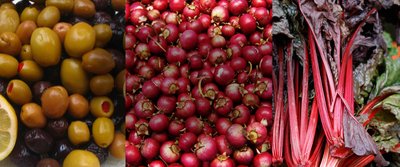Fruit is both delicious and nutritious. It's a delivery source for fiber, vitamins, minerals and antioxidants, which help keep your body in tip-top shape. However, fruit is also a source of sugar, so when people cut back their carbohydrate intake, fruit is often one of the first things on the chopping block.
To complicate matters further, fructose has been singled out as a potential contributor to obesity and cardiovascular disease.[1,2] However, research showing the detrimental effects of consuming high amounts of fructose has focused on soda and other packaged junk foods.[1] Naturally occurring sugars in foods such as fruit don't have the same health impacts as sweeteners poured into junk food and desserts.
Still, if you are watching your sugar intake, it's a good idea to be aware of which fruits are lowest in sugar. With this knowledge, you'll be able to enjoy fruit while hitting both your macros and your micros!
With a sugar-conscious mind, here's the lowdown on the top fruits with the lowest amount of the sweet stuff.
1. Olives: 0 grams of sugar per 1/2 cup
Did you know olives are a fruit? Like cherries and apricots, olives are a part of the plant that develops from a flower—in this case the flower of an olive tree—and is a seed-bearing item. So go ahead and experiment with the many olive varieties available, such as kalamata and niçoise.
These briny stalwarts of the deli counter also provide a nice antioxidant boost.[3,4] By helping to mop up cell-damaging free radicals in the body, antioxidants are thought to be a primary defense against various diseases. Antioxidants may also help to enhance the recovery process following exercise.

These briny stalwarts of the deli counter provide a nice antioxidant boost.
In the kitchen
Pizza is a natural home for olives, but you can also take advantage of these flavor bombs when making grain salads, pasta dishes, scrambled eggs, frittatas, and roasted vegetables. A sprinkling of chopped olives also goes well with meaty white fish such as halibut.
For your new favorite sandwich spread, rinse and pat dry three canned anchovy fillets. Blend anchovies, 1-1/2 cups pitted kalamata or niçoise olives, 1/2 cup oil-packed sun-dried tomatoes, 1/4 cup flat-leaf parsley, 2 chopped garlic cloves, 3 tablespoons extra-virgin olive oil, 2 tablespoons drained capers, juice of 1/2 lemon, and 1/4 teaspoon black pepper into a chunky paste.
2. Avocado: 1 gram of sugar per avocado
Like olives, avocado probably doesn't come to mind when you think of fruit. But it's classified as one botanically, and contains very little sugar. So guacamole lovers rejoice! What it lacks in sugar, avocado more than makes up for with plenty of ticker-friendly monounsaturated fat, satiating fiber, and a range of must-have vitamins and minerals.
What's more, food scientists at Ohio State University discovered that consuming avocado with items like carrots and tomatoes can increase absorption of fat-soluble beta-carotene from the latter, which can improve vitamin A status.[5] Vitamin A is essential for proper cell growth, immunity, and vision! Indeed, you can consider this buttery fruit an MVP of the produce aisle.

What it lacks in sugar, avocado more than makes up for with plenty of ticker-friendly monounsaturated fat, satiating fiber, and a range of must-have vitamins and minerals.
In the kitchen
Spread mashed-up avocado on your sandwich as a healthy alternative to mayo, or add slices to your salads, tacos, and chili. Many people blend avocado into smoothies, as it makes for deliciously thick, creamy drinks. Also, do an Internet search for "chocolate avocado pudding" and say hello to your new favorite physique-friendly dessert.
Up your pasta-night ante by blending ripe avocado with about 1/4 cup reserved pasta-cooking water, fresh lemon juice, chili powder, and a couple pinches salt for a much healthier cream sauce.
3. Rhubarb: 1 gram of sugar per cup
It's time to pucker up and embrace rhubarb, particularly if you're keeping close tabs on your carb and sugar intake. Its main nutritional highlight is the healthy amount of vitamin K it will add to your diet. Some initial reports suggest that higher intakes of vitamin K may enhance cognitive function, which becomes more important as we age.[6] Fresh rhubarb is available during the spring months, or some stores carry packages of the frozen fruit conveniently chopped up for you.

It's time to pucker up and embrace rhubarb, particularly if you're keeping close tabs on your carb and sugar intake.
In the kitchen
Time to think outside the pie when it comes to eating rhubarb. Try stewing rhubarb with items like diced onion, red wine, and mustard seed to make a chutney that can be strewn over rich meats like beef. Or simmer up rhubarb with raspberries, honey, and lemon zest for a standout sauce to be used on yogurt and ice cream. You can even add it to a pot of simmering steel-cut oats or lentils to add a pop of tart flavor.
Because of its tough consistency and tart flavor, rhubarb is not often eaten raw. But if you're pressed for time and craving the tart taste, throw rhubarb into a blender with your favorite smoothie ingredients to enhance the taste without the added sugars!
4. Cranberries: 4 grams of sugar per cup
Cranberries should be a year-round staple, instead of being relegated to the holiday season only. On top of being surprisingly low in sugar, this pucker-worthy fruit also packs some serious antioxidant power.
A study out of the Journal of Nutrition found that, when consumed daily, low-calorie cranberry juice—the kind without added sugar—may improve factors that influence the development of cardiovascular disease, such as insulin sensitivity, diastolic blood pressure, total-body inflammation, and triglyceride levels.[7]
Other nutritional highlights include notable amounts of vitamin C and fat-fighting dietary fiber.

On top of being surprisingly low in sugar, this pucker-worthy fruit also packs some serious antioxidant power.
In the kitchen
Fresh or frozen cranberries can add a flavor boost to oatmeal, yogurt, salads, roasted winter-vegetable medleys, and stews. Heck, try whirling them into your post-gym shakes. For a jazzed-up chicken salad, stir together cooked chicken, Greek yogurt, chopped cranberries, sliced almonds, sliced celery, sliced scallions, and fresh lemon juice, and put it between two warm slices of your favorite whole-grain bread.
You can also grind up cranberries in a food processor with apples, dried apricots and orange zest. Serve this no-cook sauce atop yogurt or even meats.
Learn to embrace the tartness, since bathing cranberries in sugar defeats the purpose of eating a low-sugar fruit in the first place.
5. Raspberries: 5 grams of sugar per cup
Raspberries deliver less sugar than most commonly consumed berries, so it's a good idea to always stash some fresh raspberries in the fridge or a bag of frozen ones in the freezer. Bonus: raspberries also contain more fiber than blueberries or strawberries—a lofty 8 grams per cup —so there's less chance of a sugar spike and subsequent crash.
Not only can fiber fill you up on fewer calories, some new thinking is that fiber may also affect the population of "good" bacteria in your gut. If "bad" bacteria begin to take over your gut, a disease-prone environment may be created, potentially increasing the risk for a range of cardiovascular disorders, type 2 diabetes, and obesity.[8] A diet full of fiber helps to keep the "good" bacteria thriving. Strawberries and blackberries are other lower-sugar berry options.

Raspberries deliver less sugar than most commonly consumed berries, so it's a good idea to always stash some fresh raspberries in the fridge or a bag of frozen ones in the freezer.
In the kitchen
The easiest way to work raspberries into your diet is via protein shakes, but they can also add a touch of natural sweetness to salads, oatmeal, plain yogurt, pancakes, and cottage cheese.
For a healthy fruit spread for your morning toast, heat 1-1/2 cups fresh or frozen raspberries in a saucepan over medium heat until they begin to break down, about 5 minutes. Stir in 2 tablespoons chia seeds and 1 tablespoon fresh lemon juice, and heat for another 2 minutes. Gently mash the mixture, then let it cool to thicken.
6. Kiwi: 7 grams of sugar per kiwi
Once considered exotic and rarely appearing in produce aisles, this fuzzy fruit is now a staple at the grocery store. In addition to being low in sugar, kiwi is well endowed with vitamin C, which can make eating a kiwi a day a lifesaver—literally—so consider making it a staple in your training diet. An American Journal of Clinical Nutrition study determined that higher intakes of vitamin C from fruits and vegetables can lessen the risk of coronary problems and early death from disease.[9]
Kiwi makes a good nightcap, too. A study out of the Asia Pacific Journal of Clinical Nutrition found that consuming two kiwi an hour before hitting the sack can improve sleep quality.[10] This is an important perk, considering that much of the recovery from your time in the gym happens during shut-eye.

In addition to being low in sugar, kiwi is well endowed with Vitamin C, which can make eating a kiwi a day a lifesaver—literally—so consider making it a staple in your training diet.
In the kitchen
You can simply slice kiwi in half and scoop out the sweet-tart flesh. People also blend the fruit into so-called green smoothies. Try tossing together diced kiwi, diced red bell pepper, minced jalapeno, chopped mint, and lime juice to make a salsa for fish or chicken. A bowl of protein-packed Greek yogurt can only improve when adorned with slices of kiwi. Or make it a lower-sugar addition to fruit salads.
References
- Hu, F. B., & Malik, V. S. (2010). Sugar-sweetened beverages and risk of obesity and type 2 diabetes: epidemiologic evidence. Physiology & Behavior, 100(1), 47-54.
- Bastien, M., Poirier, P., Lemieux, I., & Després, J. P. (2014). Overview of epidemiology and contribution of obesity to cardiovascular disease. Progress in Cardiovascular Diseases, 56(4), 369-381.
- Lopez-Huertas, E. & Del Rio, L.A. (2014). Characterization of Antioxidant Enzymes and Peroxisomes of Olive (Olea europaea L.) Fruits. Free Radical Biology and Medicine, 75(supp), 1-39. doi: 10.1016/j.freeradbiomed.2014.10.785.
- Drajou, M., Birmpa, A., Koutelidakis, A.E., Komaitis, M., Panagou, E.A. & Kapsokefalou, M. (2015). Total antioxidant capacity, total phenolic content and iron and zinc dialyzability in selected Greek varieties of table olives, tomatoes and legumes from conventional and organic farming. International Journal of Food Sciences and Nutrition, 66(2), 197-202.
- Kopec, R.E., Cooperstone, J.L., Schweiggert, R.M., Young, G.S., Harrison, E.H., Francis, D.M., Clinton, S.K. & Schwartz, S.J. (2014). Avocado consumption enhances human postprandial provitamin A absorption and conversion from a novel high-beta-carotene tomato sauce and from carrots. Journal of Nutrition, 144(8), 1158-1166.
- Presse, N., Belleville, S., Gaudreau, P., Greenwood, C.E., Kergoat, M.J., Morais, J.A., Payette, H., Shatenstein, B. & Ferland, G. (2013). Vitamin K status and cognitive function in healthy older adults. Neurobiology of Aging, 34(12), 2777-2783.
- Novotny, J.A., Baer, D.J., Khoo, C., Gebauer, S.K. & Charron, C.S. (2015). Cranberry juice consumption lowers markers of cardiometabolic risk, including blood pressure and circulating C-reactive protein, triglyceride, and glucose concentrations in adults. Journal of Nutrition, 145(6), 1185-1193.
- Chu, H., & Mazmanian, S. K. (2013). Innate immune recognition of the microbiota promotes host-microbial symbiosis. Nature immunology, 14(7), 668-675.
- Kobylecki, C.J., Afzal, S., Smith, G.D. & Nordestgaard, B.G. (2015). Genetically high plasma vitamin C, intake of fruit and vegetables, and risk of ischemic heart disease and all-cause mortality: a Mendelian randomization study. American Journal of Clinical Nutrition, 101(6), 1135-1143.
- Lin, H.H., Tsai, P.S., Fang, S.C. & Liu, J.F. (2011). Effect of kiwifruit consumption on sleep quality in adults with sleep problems. Asia Pacific Journal of Clinical Nutrition, 20(2), 169-174.

